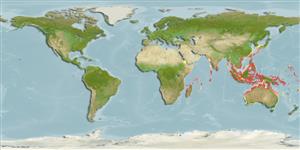Common names from other countries
>
Kurtiformes (Nurseryfishes, cardinalfishes.) >
Apogonidae (Cardinalfishes) > Apogoninae
Etymology: moluccensis: Named for the place of its type locality. Molucca Islands, Indonesia..
More on author: Valenciennes.
Environment: milieu / climate zone / depth range / distribution range
Ecologia
marinhas associadas(os) a recifes; intervalo de profundidade 3 - 30 m (Ref. 11893). Tropical
Indo-Pacific: South Africa and India eastward to Fiji; north to Taiwan, south to Australia.
Tamanho / Peso / Idade
Maturity: Lm ? range ? - ? cm
Max length : 9.0 cm TL macho/indeterminado; (Ref. 2334)
Descrição suscinta
Chaves de identificação | Morfologia | Morfometria
Espinhos dorsais (total) : 8; Raios dorsais (total) : 9; Espinhos anais: 2; Raios anais : 8; Vértebras: 24. Distinguished from other species of Apogon in the subgenus Ostorhinchus with 21-25 rudiments + gill rakers, 14-17 lower arch developed gill rakers; the roof of the mouth and portions of gill arches pale; a whitish spot behind the posterior base of the second dorsal fin (Ref. 58519).
Nocturnal species. Occurs inshore (Ref. 7300); usually in silty habitat on mud slopes, in lagoons, and sheltered reefs. Usually seen in pairs or schooling, comprising numerous pairs when adult (Ref. 48635).
Ciclo de vida ou comportamento de acasalamento
Maturities | Reprodução | Spawnings | Egg(s) | Fecundities | Larvas
Mouthbrooders (Ref. 240). Distinct pairing during courtship and spawning (Ref. 205).
Randall, J.E., G.R. Allen and R.C. Steene, 1990. Fishes of the Great Barrier Reef and Coral Sea. University of Hawaii Press, Honolulu, Hawaii. 506 p. (Ref. 2334)
Status na Lista Vermelha da UICN (Ref. 130435)
CITES (Ref. 128078)
Not Evaluated
Ameaça para os humanos
Harmless
Uso pelos humanos
Ferramentas
Relatórios especiais
Baixar XML
Fontes da internet
Estimates based on models
Preferred temperature (Ref.
115969): 26 - 29.3, mean 28.6 (based on 2550 cells).
Índice de diversidade filogenética (Ref.
82804): PD
50 = 0.5000 [Uniqueness, from 0.5 = low to 2.0 = high].
Bayesian length-weight: a=0.01288 (0.00551 - 0.03009), b=3.10 (2.92 - 3.28), in cm Total Length, based on LWR estimates for this Genus-body shape (Ref.
93245).
Nível Trófico (Ref.
69278): 3.5 ±0.4 se; based on size and trophs of closest relatives
Resiliência (Ref.
120179): Elevada, tempo mínimo de duplicação da população menor que 15 meses (Preliminary K or Fecundity.).
Fishing Vulnerability (Ref.
59153): Low vulnerability (10 of 100).
